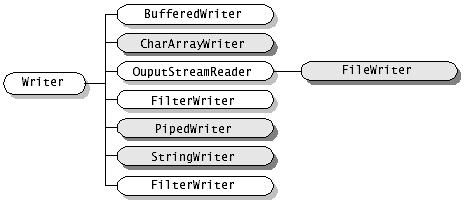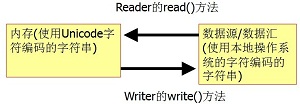标签:
8. 字符流Writer/Reader
Java中字符是采用Unicode标准,一个字符是16位,即一个字符使用两个字节来表示。为此,JAVA中引入了处理字符的流。
用于读取字符流的抽象类。子类必须实现的方法只有 read(char[], int, int) 和 close()。但是,多数子类将重写此处定义的一些方法,以提供更高的效率和/或其他功能。

1) FileReader :与FileInputStream对应
主要用来读取字符文件,使用缺省的字符编码,有三种构造函数:
(1)将文件名作为字符串 :FileReader f=new FileReader(“c:/temp.txt”);
(2)构造函数将File对象作为其参数。
File f=new file(“c:/temp.txt”);
FileReader f1=new FileReader(f);
(3) 构造函数将FileDescriptor对象作为参数
FileDescriptor() fd=new FileDescriptor()
FileReader f2=new FileReader(fd);
(1) 用指定字符数组作为参数:CharArrayReader(char[])
(2) 将字符数组作为输入流:CharArrayReader(char[], int, int)
读取字符串,构造函数如下: public StringReader(String s);
2) CharArrayReader:与ByteArrayInputStream对应
3) StringReader : 与StringBufferInputStream对应
4) InputStreamReader
从输入流读取字节,在将它们转换成字符:Public inputstreamReader(inputstream is);
5) FilterReader: 允许过滤字符流
protected filterReader(Reader r);
6) BufferReader :接受Reader对象作为参数,并对其添加字符缓冲器,使用readline()方法可以读取一行。
Public BufferReader(Reader r);
主要方法:
(1) public int read() throws IOException; //读取一个字符,返回值为读取的字符
(2) public int read(char cbuf[]) throws IOException; /*读取一系列字符到数组cbuf[]中,返回值为实际读取的字符的数量*/
(3) public abstract int read(char cbuf[],int off,int len) throws IOException;
/*读取len个字符,从数组cbuf[]的下标off处开始存放,返回值为实际读取的字符数量,该方法必须由子类实现*/
写入字符流的抽象类。子类必须实现的方法仅有 write(char[], int, int)、flush() 和 close()。但是,多数子类将重写此处定义的一些方法,以提供更高的效率和/或其他功能。 其子类如下:

1) FileWrite: 与FileOutputStream对应
将字符类型数据写入文件,使用缺省字符编码和缓冲器大小。
Public FileWrite(file f);
2) chararrayWrite:与ByteArrayOutputStream对应 ,将字符缓冲器用作输出。
Public CharArrayWrite();
3) PrintWrite:生成格式化输出
public PrintWriter(outputstream os);
4) filterWriter:用于写入过滤字符流
protected FilterWriter(Writer w);
5) PipedWriter:与PipedOutputStream对应
6) StringWriter:无与之对应的以字节为导向的stream
主要方法:
(1) public void write(int c) throws IOException; //将整型值c的低16位写入输出流
(2) public void write(char cbuf[]) throws IOException; //将字符数组cbuf[]写入输出流
(3) public abstract void write(char cbuf[],int off,int len) throws IOException; //将字符数组cbuf[]中的从索引为off的位置处开始的len个字符写入输出流
(4) public void write(String str) throws IOException; //将字符串str中的字符写入输出流
(5) public void write(String str,int off,int len) throws IOException; //将字符串str 中从索引off开始处的len个字符写入输出流
(6) flush( ) //刷空输出流,并输出所有被缓存的字节。
(7)close() 关闭流 public abstract void close() throws IOException
InputStream和OutputStream类处理的是字节流,数据流中的最小单位是字节(8个bit)
Reader与Writer处理的是字符流,在处理字符流时涉及了字符编码的转换问题
import java.io.*;
public class EncodeTest {
private static void readBuff(byte [] buff) throws IOException {
ByteArrayInputStream in =new ByteArrayInputStream(buff);
int data;
while((data=in.read())!=-1) System.out.print(data+" ");
System.out.println(); in.close(); }
public static void main(String args[]) throws IOException {
System.out.println("内存中采用unicode字符编码:" );
char c=‘好‘;
int lowBit=c&0xFF; int highBit=(c&0xFF00)>>8;
System.out.println(""+lowBit+" "+highBit);
String s="好";
System.out.println("本地操作系统默认字符编码:");
readBuff(s.getBytes());
System.out.println("采用GBK字符编码:");
readBuff(s.getBytes("GBK"));
System.out.println("采用UTF-8字符编码:");
readBuff(s.getBytes("UTF-8")); }
}

Reader类能够将输入流中采用其他编码类型的字符转换为Unicode字符,然后在内存中为其分配内存
Writer类能够将内存中的Unicode字符转换为其他编码类型的字符,再写到输出流中。
9. IOException异常类的子类
1.public class EOFException :
非正常到达文件尾或输入流尾时,抛出这种类型的异常。
2.public class FileNotFoundException:
当文件找不到时,抛出的异常。
3.public class InterruptedIOException:
当I/O操作被中断时,抛出这种类型的异常。
标签:
原文地址:http://my.oschina.net/weiweiqiao/blog/498963